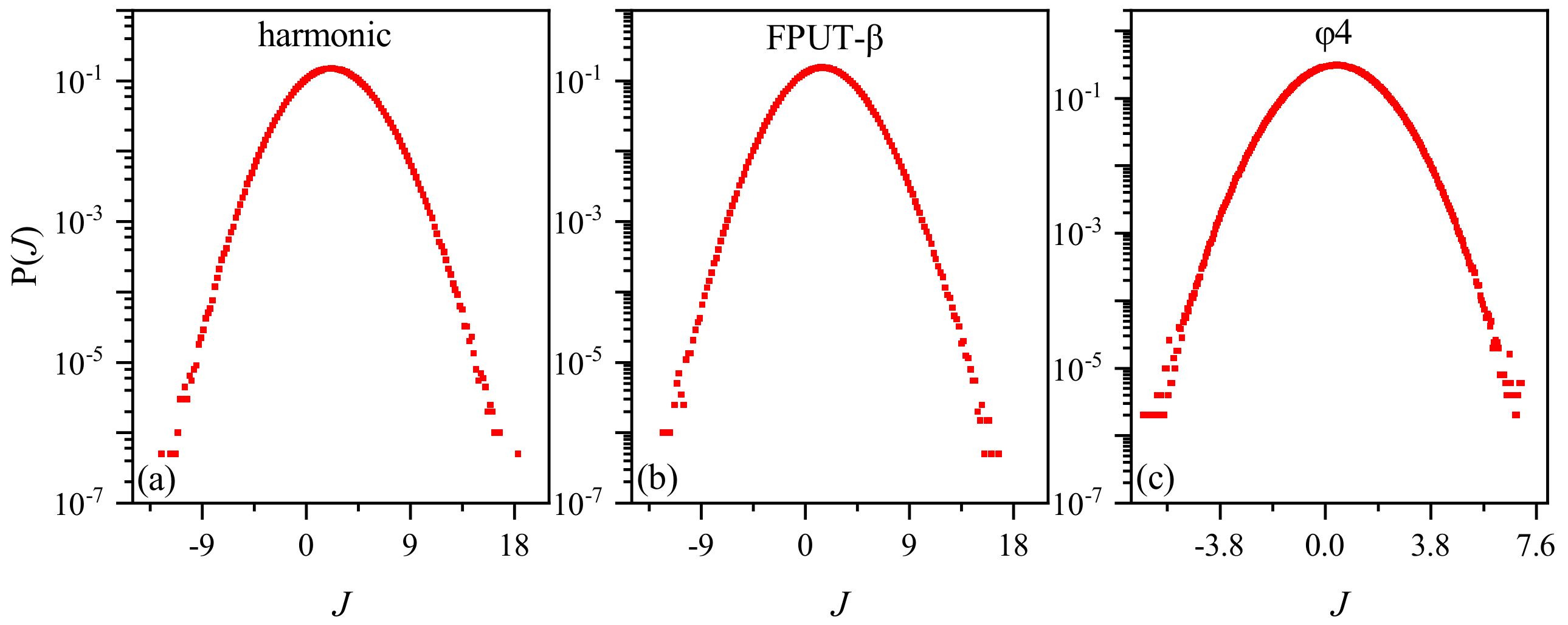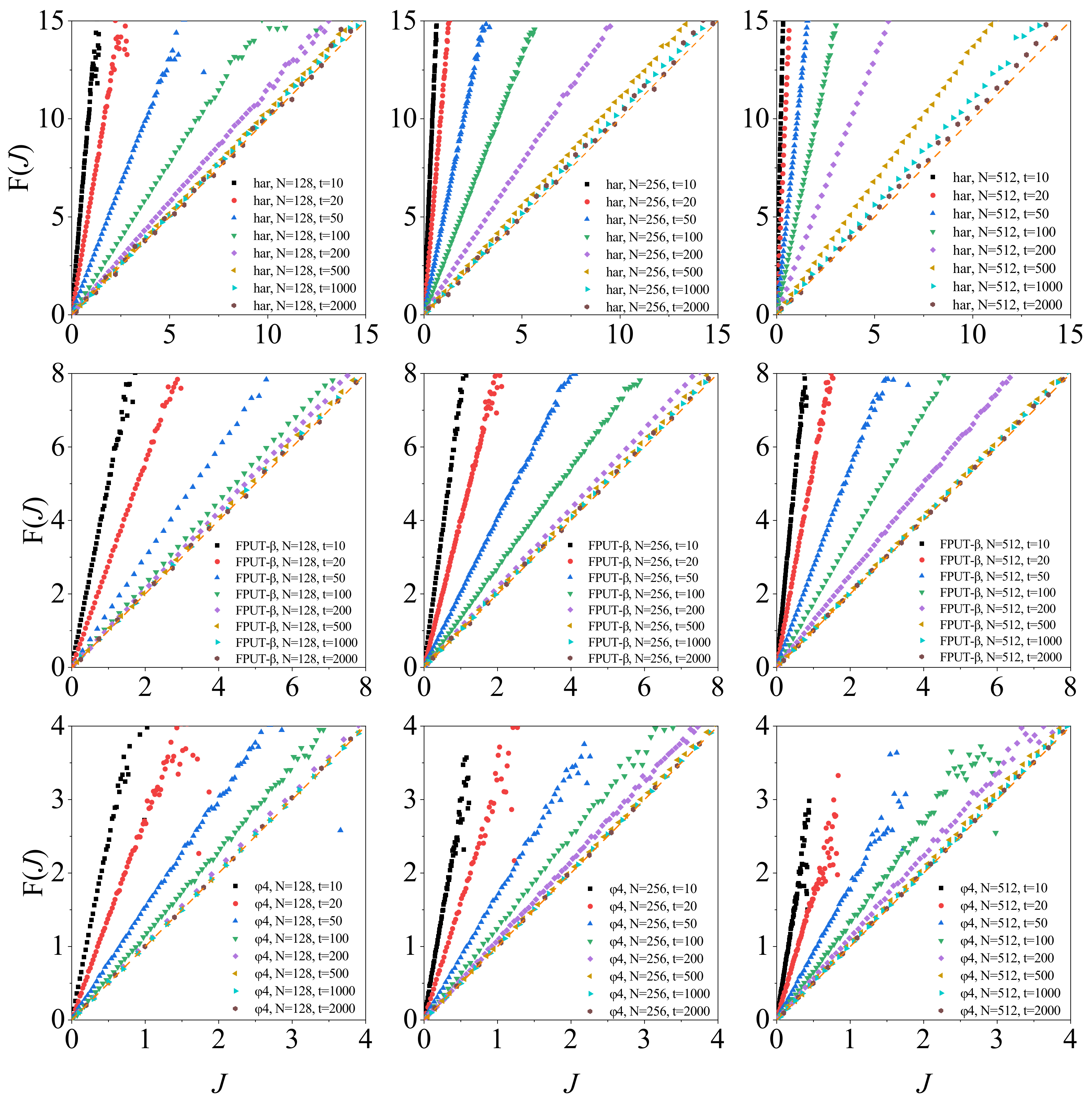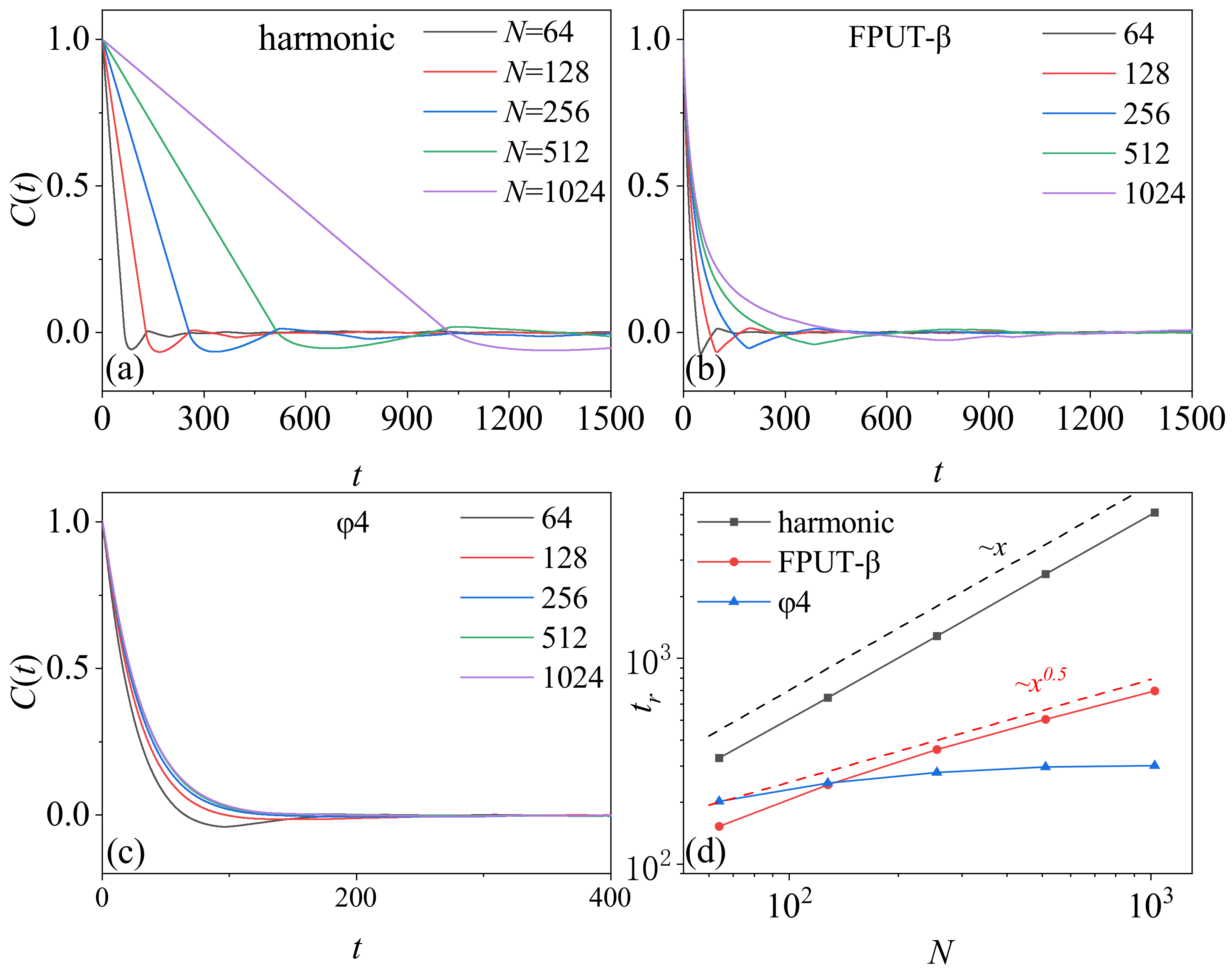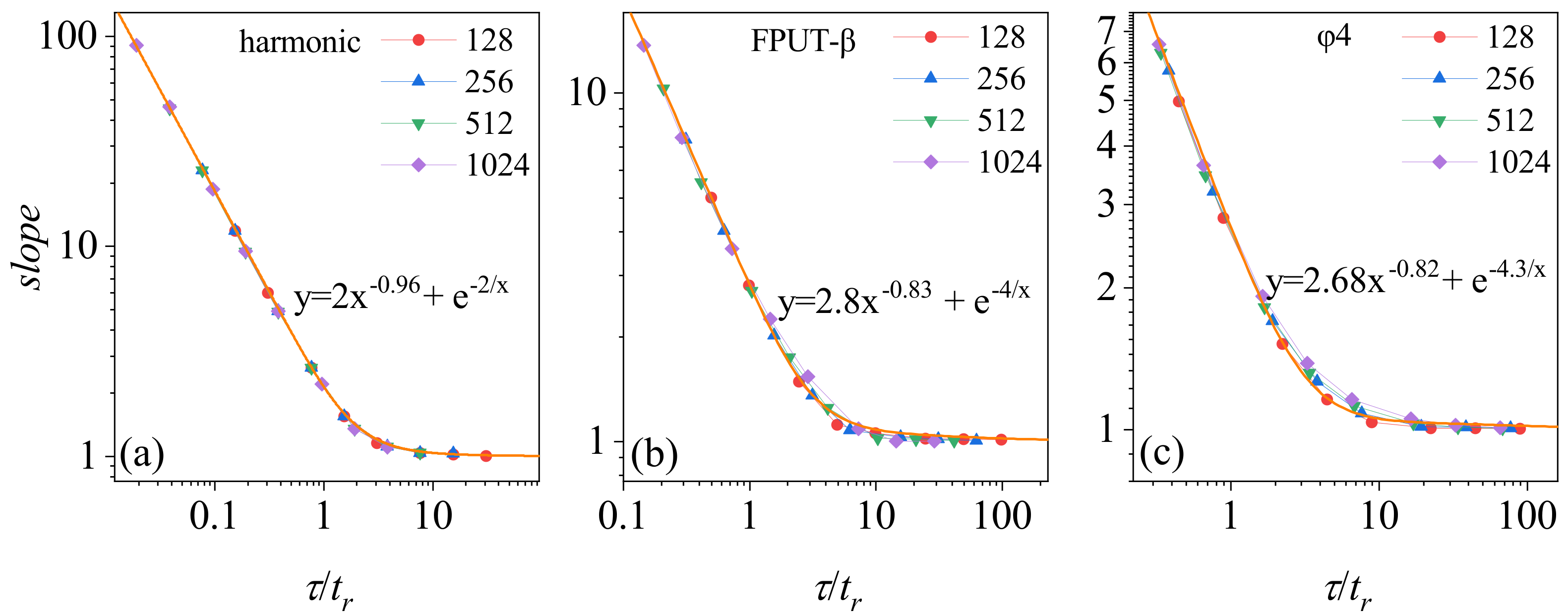1. Introduction
The 1990s witnessed the advent of fluctuation relations by authors like Evans, Gallavotti, Jarzynski and Crooks, revolutionizing statistical physics and nonequilibrium thermodynamics [
1,
2,
3,
4,
5,
6]. These relations extended the second law of thermodynamics into a statistical–physical framework, embracing both increases and decreases in entropy. Their ratios of positive and negative entropy events are shown to rise exponentially with larger measurement times and system sizes, seamlessly bridging micro and macro thermodynamic theories and earmarking the fluctuation relation as a pivotal development in nonequilibrium statistical physics. Transient fluctuation relations for
time-reversible dynamics are exact for systems of any size, near and far from equilibrium, and over any observation time [
4,
5,
7,
8,
9]. On the other hand,
steady-state fluctuation relations, apparently similar or directly derivable from transient relations, are only asymptotically valid hence not exact, and require proper conditions to be verified concerning the time correlation function of the dissipation [
8,
10,
11]. We will see, however, that exact relations can be verified at any finite time, when the proper correlation functions can be evaluated, cf. [
8,
12].
Nonequilibrium steady-state heat flow fluctuations are very convenient for testing the fluctuation relations. Under the local equilibrium hypothesis, local entropy generation links directly to heat flow, connecting to the system’s total entropy change. Lepri, Livi and Politi’s 1998 application of fluctuation relations for the dissipation function [
13] to nonequilibrium steady-state heat flow fluctuations, validated by numerical simulations in the Fermi–Pasta–Ulam–Tsingou(FPUT)
lattice model, laid the groundwork for further exploration [
14]. Subsequent studies by Van Zon, Cohen, Jarzynski and Dhar et al. expanded this theorem’s applicability, to a variety of systems, including the harmonic oscillator chain [
10,
15,
16,
17,
18]. These findings, however, raise a key question: does compliance reflect the system’s dynamical characteristics or the influence of the heat bath? Furthermore, the need for larger time windows in larger systems seems to contradict the expectation that larger systems should more readily adhere to thermodynamic laws.
Our research addresses these complexities by examining three distinct one-dimensional lattice models: the harmonic oscillator chain,
and the
lattice model, each representing a unique thermal conduction class. The harmonic oscillator chain lacks chaotic motion, exhibiting a system-size proportional thermal conductivity,
∼
N. The
and
lattice models, with chaotic motion, show divergent and size-independent thermal conductivity, respectively [
19,
20,
21,
22,
23,
24]. This divergence in heat conduction behaviors presents a compelling study contrast.
We demonstrate that, for a fixed system size, each model satisfies the steady-state fluctuation relations for the dissipation function within sufficiently large observational time windows [
25], albeit through differing mechanisms. In lattices with anomalous heat conduction, compliance stems from the heat baths at the chain ends, where bath fluctuations permeate the entire chain given adequate time. Conversely, in lattices with normal heat conduction, bath fluctuations diminish rapidly, and theorem compliance is dictated by the system’s statistical physical behavior. Notably, when the observation time is scaled with the characteristic correlation time, a universal, size-independent fluctuation relation emerges. This discovery underscores the correlation’s disappearance as indicative of steady-state fluctuation relations satisfaction, and enabling predictions of fluctuation relations in longer chains based on shorter ones.
The structure of this paper is organized as follows. The next section presents an introduction to the fluctuation relation for dissipation function. We derive the steady-state fluctuation relation from the transient fluctuation relation, building on the foundational work of Evans and Searles [
9]. This derivation particularly emphasizes the connection between the fluctuation relation and the decay of correlations caused by dissipation [
8]. In
Section 3, we introduce the models that will be examined in our study.
Section 4 is dedicated to reporting our principal findings. It shows that there is indeed a variety of possible behaviors determining the decay of correlation, revealing the physical mechanisms leading to the satisfy of the steady fluctuation at different levels. Finally,
Section 5 provides a comprehensive summary of our work.
2. Steady-State Fluctuation Relation
The authors of Ref. [
1] considered the Gaussian iso-energetic SLLOD model of a shearing fluid, for
N particles in
d dimensions, cf.
Appendix A, and proposed and tested the following fluctuation relation:
inspired by the theory of Anosov dynamical systems, cf.
Appendix B, which they adapted to the time-reversal invariant SLLOD equations of motion. In this formula,
represent conjugate phase space trajectory segments of length
,
is the
n-th finite-time Lyapunov exponent computed along the segment
i in a time
, and
is proportional to the average energy dissipation rate, along one trajectory segment of duration
. Then,
is the steady-state probability of trajectory segments of length
yielding the same
, and
is the probability of segments yielding the opposite value,
. The result, according to the theory of large deviations, is then verified by taking larger and larger averaging times
. In local thermodynamic equilibrium, Equation (
1) quantifies the second law for reversible dynamics, which is what made it initially very popular. Consequently, in near equilibrium situations it yields linear response with Onsager and Green–Kubo relations [
26,
27]. Moreover, its derivation from pure dynamics makes the fluctuation relation suitable to go beyond the local thermodynamic equilibrium regime, and of particular interest in the field of small and low-dimensional systems. In that realm, unlike the macroscopic one, fluctuations are observable and comparable to observed average signals. The work on steady-state fluctuations led to the transient fluctuation relation, derived in 1994 by Evans and Searles [
9], and that opened the way to a different understanding of the steady-state one, not based on the Anosov assumption [
26], cf.
Appendix C. Here, we concisely illustrate this approach, which explains our findings.
One fundamental property of the molecular dynamics systems for which the fluctuation relations have been derived is that they are dissipative, which allows systems to reach steady states, but time-reversal invariant. This can be abstractly described as follows. Let
be the phase space and
evolution in
, so that
is the phase
reaches at time
t. In the cases of our interest,
yields the solution of the equations of motion
. For instance, given the one-dimensional harmonic oscillator equations:
one has
, and:
The dynamics are called dissipative if the time average of the divergence of the vector field
is negative. When this is the case, the system is not Hamiltonian. In particular, negative
means that phase space volumes contract. However, time reversibility may still hold. Indeed, it suffices that the equations of motion are invariant under the inversion of time
, combined with the transformation
where
is the collection of positions and momenta of the particles of the system of interest, cf.
Appendix B. This also implies that the trajectories stemming from the initial conditions
and
trace back each other in configuration space for a time
t, and lead to the following general definition. Then, the dynamics are called time-reversal invariants if there exists one transformation
whose double application is the identity, such that
Such a general definition is motivated by the fact that
, i.e., that the reversal operation generates the backward evolution, and it was implicit in Ref. [
1], because the SLLOD equations are not invariant under the time-reversal operation defined by Equation (
5), but they are under, e.g., the following mapping:
Let
be an initial probability distribution on
, and define the
dissipation function as:
Its name is justified by the fact that
represents indeed the dissipated power, if
is the equilibrium (non-driven) distribution that obeys the same constraints of the driven dynamics [
8]. That is the case for the situation investigated in Ref. [
1], which is shown in
Appendix A. Finally, we denote by
the time integral between the times
t and
of any observable
, computed along the trajectory starting at
. Consequently, we can write:
The quantity
divided by
gives the corresponding time average
. With such definitions, the derivation of the transient fluctuation relation is just a few lines.
First, one notices that the corresponding Liouville equation in Eulerian form is expressed by:
and in Eulerian form by:
Therefore, given the initial distribution
, which in general is not invariant for the driven dynamics, one obtains [
28]:
for the distribution at time
t. Then, one introduces the intervals of values around
A and
,
with small
, and observes that:
which is to say that all initial conditions
that yield the time average
are obtained from those
that yield
, evolving them for a time
and applying the reversal operation
i. Denote by
the probability computed with respect to the initial distribution
that the average of
takes values near
A. Then, the ratio of initial probabilities to find values
A and
is expressed by:
and introduce the coordinate transformation
, with Jacobian
which leads to:
if
is even under the application of
i, i.e.,
, as appropriate for an equilibrium distribution. The transient fluctuation relation immediately follows:
with an error
that is not larger than
, although it depends on all parameters of the theory. Therefore,
can be made as small as one wants, by taking
as correspondingly small. This also means:
where the right-hand side means the inverse of the average of the exponential of
integrated from time 0 to time
, over the trajectories that yield a value close to
A, with a difference not larger than
. Indeed,
is the conditional average of
over the trajectories whose initial conditions lie in
, which is to say the average with respect to the distribution
which assigns zero probability to the sets outside
.
The transient fluctuation relation is very robust because it is based on minimal assumptions: time reversibility and conservation of probability in phase space. It is an identity that holds exact for all , for an ensemble of experiments all starting in the initial state characterized by , analogously to other fluctuations such as the Jarzynski equality.
To derive the steady-state fluctuation relation, we can now start from Equation (
19). First, we move from the probability
to the statistic resulting at time
t, under the assumption that probability is conserved and moves around the phase space together with the phases
. This means that the probability of a set
at time
t,
say, equals the probability at time 0 of the set of points that reach
E at time
t,
, which can be written as
We will then try to extrapolate the result to the steady state, by letting
t grow without bounds. With minimal algebra, Equation (
21) yields another exact relation:
Here, the second line yields the expression of the fluctuation relation, in the
limit, if such a limit exists, and the conditional average behaves properly when
becomes large. Therefore, although it is derived from an exact transient relation that practically always holds, the steady-state fluctuation relation does not always makes sense, and when it does it does not necessarily correspond to the exponential unbalance of probabilities expressed by the original relation (
1). Indeed, the
of the conditional average may diverge, or it may yield a non-negligible contribution, even in the
limit. When this term constitutes a correction that vanishes as
, we have a situation analogous to the one discussed within the Anosov formalism. In all circumstances, it is a relation that only becomes exact when
grows, unlike the transient fluctuation relation, which is exact for all
. Another difference between the transient and the steady-state relations is that the second applies also to the fluctuations along a single trajectory, and does not need an ensemble.
Remark 1. The last term of Equation (24) must vanish when the limit is taken after the limit . This is not only a sufficient condition but it is also necessary, because Equation (24) is an exact relation. This says that correlations of the dissipation function with respect to the initial distribution follow a given rule, when reversible dynamical systems verify the steady-state fluctuation relation. This behavior of the correlations of the dissipation function constitutes the mechanism implying the validity of the steady-state fluctuation relation. The relation is violated under different conditions [8]. To understand the significance of the last term in Equation (
24), consider the case in which the correlations with respect to the initial distribution
decay instantaneously. Considering that the conditional average then turns equal to the full average, and that the transient fluctuation relation, with some manipulation, also yields [
8]:
one obtains:
where
represents the full phase space average with respect to
, cf. [
8]. This implies that the steady state is verified at an arbitrarily short
. If the decay of correlations is not immediate with a growing
, the final result will depend on how they depend on
. An investigation of these issues was performed in Ref. [
29] for color diffusion molecular dynamics. In that case, it was found that the correlations decay, hence the steady-state fluctuation relation is verified. Below, we will see that there is indeed a variety of possible behaviors, determined by the physical mechanisms at work.
Ref. [
25] considered the classical many-body system that is in contact with two thermal reservoirs maintained at different temperatures, and proposed the equivalence between thermodynamic entropy and the dissipation equation:
where
and
are the instantaneous heat flow between systems and the heat baths, respectively. Here,
.
Based on this equivalence relationship, the above steady-state fluctuation relation for the dissipation function can be extended to the steady-state fluctuation relation of heat flow. At the same time, by integrating the local entropy generation, we can obtain the total entropy generation of the system when the time interval is t as follows:
When the time interval for observation is
, the cumulative heat flow of the system is
. When the system is in a steady state, the local heat flow is on time average equal everywhere, so
. From this, we obtain the steady-state fluctuation relation of heat flow [
13,
30,
31]:
where
is the probability that the cumulative heat flow with the time interval
takes values near
J.
Defining
our target is to verify whether the fluctuations satisfy
4. Results
In
Figure 2, we present the distribution of heat-flow fluctuation for the three models with
and
. Throughout our simulation in this paper, we fix the average temperature,
T, of two heat baths as 0.5 and the temperature difference,
, as 0.1. We note that they exhibit Gaussian-like distribution for all three models, with no significant difference. Gaussian-like distributions of heat-flow fluctuation have been observed in [
13], and their reason has been discussed theoretically [
32,
33].
Figure 3 shows
vs.
J as a function of
for several lattice sizes for the three models. It can be observed that, at short time intervals, the prediction of the steady-state fluctuation relation is violated, although
and
J shows a linear dependence. When
is large enough, the prediction is always approached for all three models.
However, there are significant disparities. In the case of the harmonic oscillator model and the
model, we require increasingly larger values of
to align with the theoretical predictions as the chain’s length grows. Notably, for a given length, the time window required is greater for the former than for the latter, as illustrated in the first two lines of
Figure 3. This is in line with the integrability of the purely harmonic chains, which are at the opposite end of thermodynamics. It is important to highlight that testing the theorem becomes quite challenging for lengthy chains, given the infrequent occurrence of negative heat flow events. Consequently, one must allow the system to evolve for an extended period to obtain an effective distribution function. Indeed, when dealing with the harmonic model, this task is nearly beyond the computational capacity for
. As a result, direct observation of results converging to the theoretical prediction becomes infeasible. From a theoretical standpoint, even though these models can eventually fit the prediction, our analysis reveals that they defeat conventional wisdom. According to this, which larger systems adhere better to the standard statistical descriptions characterizing thermodynamic systems? This, perhaps perplexing, point will be clarified by the analysis of the other models. What is more, we observe a counterintuitive trend in this context, which may be related to the growth fluctuation magnitude with
N.
For the
model, once the size of the chain exceeds a threshold,
in this case, the dependence of
to
J for a given
becomes identical, as shown in the last line of
Figure 3. As a result, for this model, the steady-state fluctuation relation can be generally satisfied for relatively long chains (with about
) and relatively large
(with about
). In practical applications involving real-world materials and measurable time scales, one can conclude that the
model consistently satisfies the theorem.
To understand the mechanism, we calculated the correlation function
of heat flow fluctuation of the three models under a nonequilibrium steady state. We observe that, although
decays to zero with the increase of time, the behavior is different for each model. In the case of the harmonic model,
decays linearly with time, and the rate of decay decreases as a function of the chain’s length. In the
model, the function of decay is no longer linear, but the rate of decay still decreases with the increase of the chain length. In the
model, however,
decays very rapidly compared with the other two models. Particularly, it becomes size-independent when the chain length exceeds a threshold,
. We define
to measure the cumulative correlation.
Figure 4d shows
as a function of
N. It can be seen that, when the system size is larger,
scales as
, with
values of 1, 0.5 and 0 for the three models, respectively. Interestingly, these scaling relations match those observed in their thermal conductivity dependence on chain size, where
,
and
for the three models, respectively.
We argue that the behavior of
is a result of the interplay between the heat baths and the system’s dynamics. In the harmonic model, we know that
in the absence of a heat bath, since it is an integrable model. In the present of heat baths, the fluctuation from the heat baths propagates to the system at the speed of sound, which is a unit with dimensionless parameters in this context. As these fluctuations are inherently random, they are expected to induce the decrease of
. For a rough estimation, we suppose that, once the fluctuations are transported, the correlation of that part of the chain disappears, and the correlation vanishes after
. Therefore,
. Here,
characterize the decrease of the region of the sum in the equation. Here, we suppose that the fluctuation spread out with the sound velocity, and thus
. As a consequence,
. This estimation aligns well with
Figure 4a,d. The value of
defines the characteristic time that
vanishes, since
is normalized to unity. Therefore, once the fluctuations spread throughout the system over a timescale of
, the correlation vanishes, and the fluctuation relation applies in accordance with the theory of the dissipation function [
8,
29,
34,
35].
In the
model, it is widely recognized that the system exhibits chaotic motion, which can induce the decay of the correlation function. Nevertheless, the decay follows a power-law behavior, with
, as evidenced by studies in the equilibrium state [
30,
36,
37,
38]. Therefore, the behavior of
results from both the effects of the heat bath and the system itself, which can be estimated as
. This estimation yields
. These results are consistent with
Figure 4b,d. Due to the non-vanishing correlation within the system, the heat baths continue to play a role in eliminating the correlation, resulting in a timescale of
to ensure the system satisfies the fluctuation relation.
In the
model, the system is also chaotic but the fluctuation of heat flow decays as
. Even without attributing to the heat baths,
decays to zero before
. This explains the results of
Figure 4c. Consequently, once the chain length exceeds a threshold, the correlation vanishes after a critical time that is independent of the system size, and, thus, the fluctuation relation applies hereafter.
The reason why the fluctuation relation is satisfied after the vanishing of the correlation heat flow fluctuations is as follows. When there is no correlation between the fluctuations, the distribution of fluctuations appears as a Gaussian distribution
, according to the central limit theorem [
32,
33,
39]. We then obtain
. With
, we obtain
, i.e., the steady-state fluctuation relation.
Based on the foregoing analysis, we can re-scale
to render it system-size independent. Denote the slope of the
curve in
Figure 5 as
. We re-scale
with respect to
and plot
as a function of
in
Figure 5. It can be observed that
manifests as a system-size independent curve,
. As such, it can be regarded as an extension of the fluctuation relation for an arbitrary
. The limit of
approaching unity as
tends to infinity indicates the satisfaction of the original steady-state fluctuation relation. The universality of the harmonic oscillator model is exemplary, and the other two are also fundamentally consistent for larger sizes. Technically, one can employ the universal curve to extrapolate the results obtained for a fixed chain length to other sizes without the need for further calculations when the scalings apply.
The relationship of
with
arises from persistent correlations. Notably, the global heat flow distribution retains its Gaussian character, even at smaller values of
. This phenomenon is explained by the process of calculating global heat flow: the averaging of local heat flows from
N particles, each exhibiting random heat flow characteristics. Consequently, the global heat flow represents an aggregation of numerous small, random variables, aligning with a Gaussian distribution, as dictated by the central limit theorem. The variance of the instantaneous heat flow distribution, measured over a unit time, is denoted as
. Taking the harmonic chain as an example, and assuming a steady heat flow correlation over an exceedingly brief
(
, while neglecting decay due to heat baths), we find that the variance in heat flow fluctuations is represented by
. Hence,
approximates
, in agreement with the power law index (−0.96) observed for a small
in
Figure 5a. The
-dependence of
in the other two models similarly stems from the enduring correlations of heat flow fluctuations.











